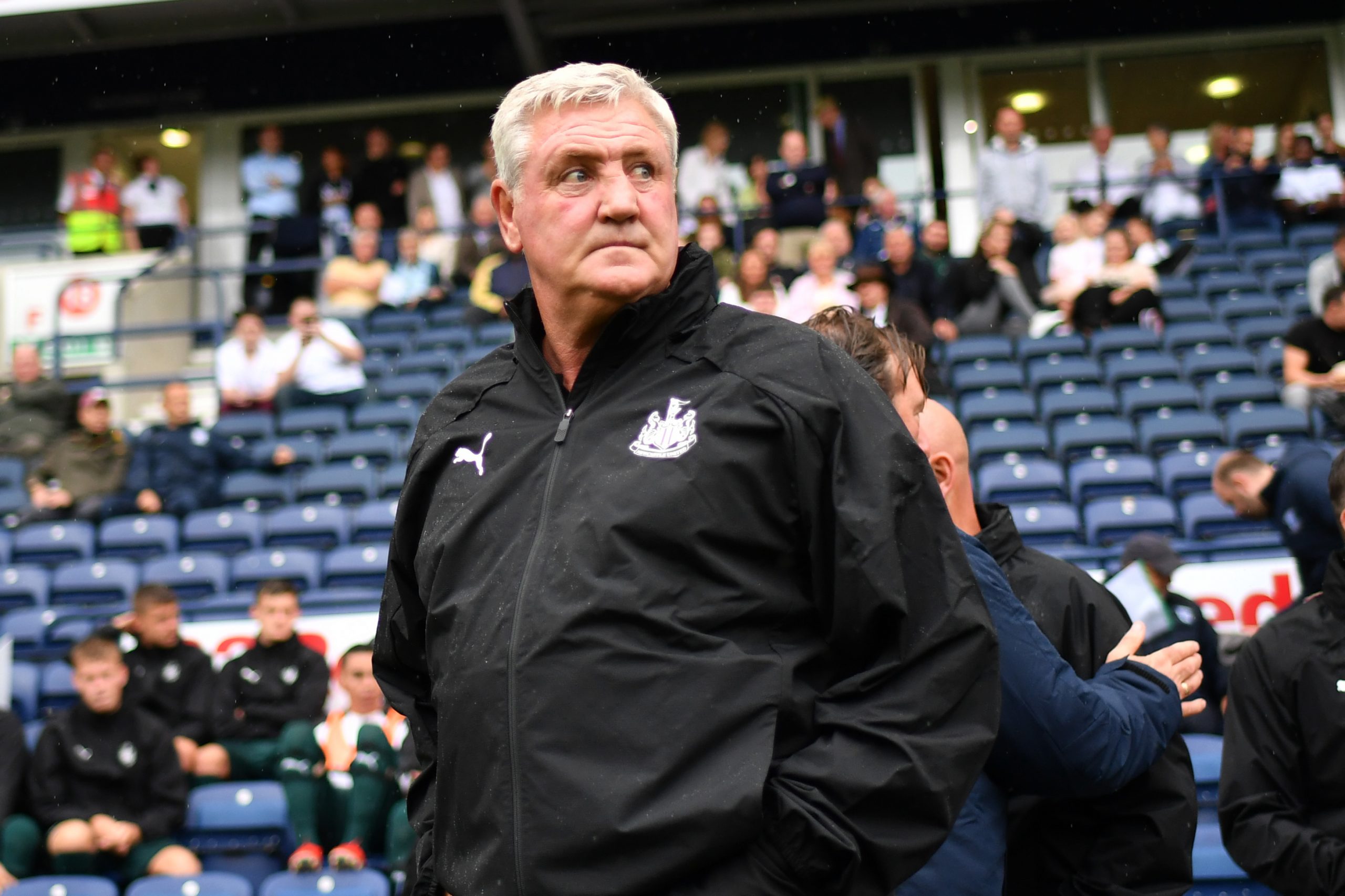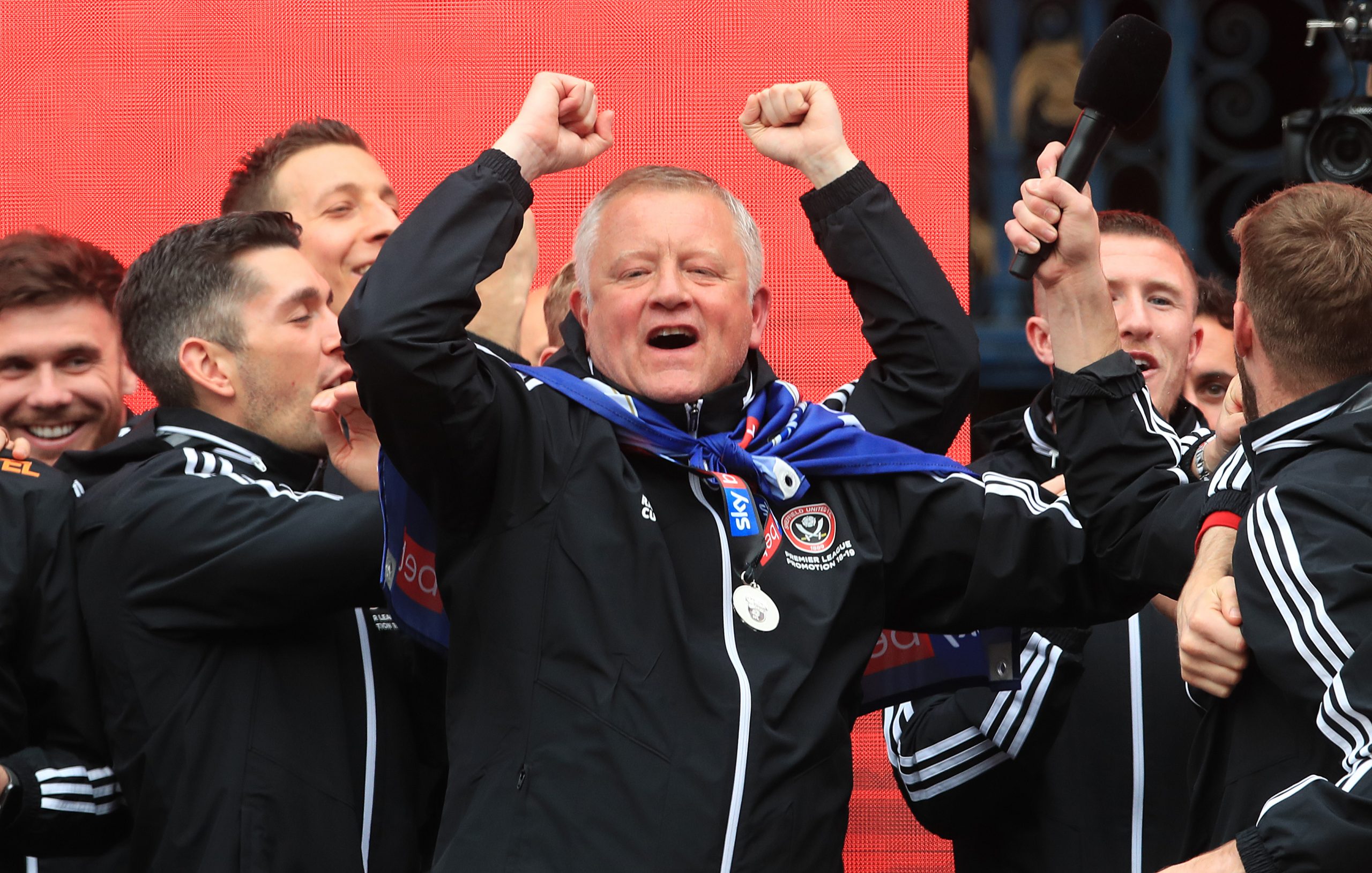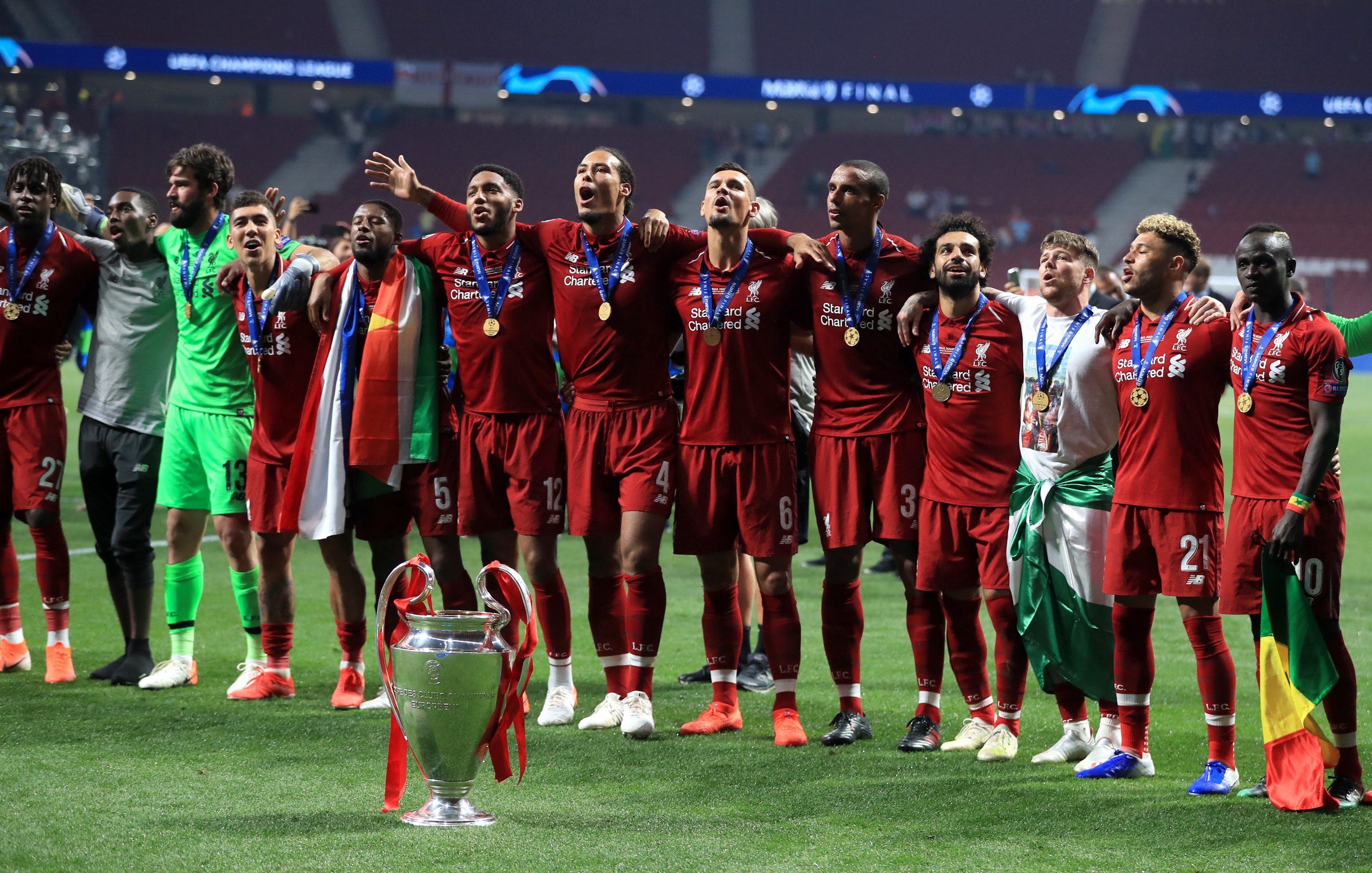You know that your club’s situation is bad when fans of other teams feel so bad making taunts that they actively hope things get better for you. Newcastle fans, like those of Leeds, are probably sick of hearing “y’know, it’d be nice if you guys were good again.” As the summer stretched slowly towards its unexpected scorching peak, it looked like Newcastle’s attacking stock would be running dry come 2019/20. Almost all of their forwards seemed to leave. Gone were the top three expected goals contributors, and two of the top four expected goals assisters left too (out of players who played more than 600 minutes). 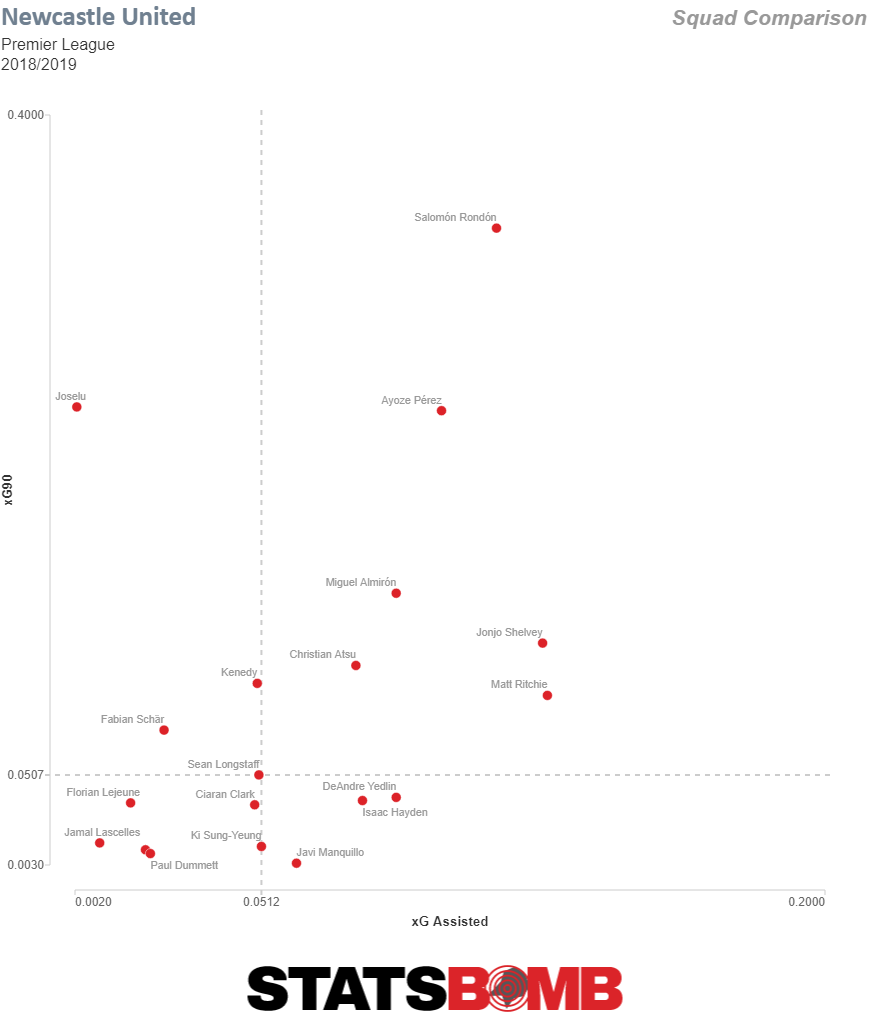 They do still have Miguel Almiron of course, and Yoshinori Muto (um… who, in limited minutes, averaged just 0.75 shots per 90 last season). And Matt Ritchie and Jonjo Shelvey. It’s a good thing, then, that Newcastle spent around £35m on 22-year-old Joelinton. The Brazilian forward arrives from Hoffenheim with some slightly-better-than-league-average radars and a 0.51 goal contribution per 90 minutes rate in tow.
They do still have Miguel Almiron of course, and Yoshinori Muto (um… who, in limited minutes, averaged just 0.75 shots per 90 last season). And Matt Ritchie and Jonjo Shelvey. It’s a good thing, then, that Newcastle spent around £35m on 22-year-old Joelinton. The Brazilian forward arrives from Hoffenheim with some slightly-better-than-league-average radars and a 0.51 goal contribution per 90 minutes rate in tow. 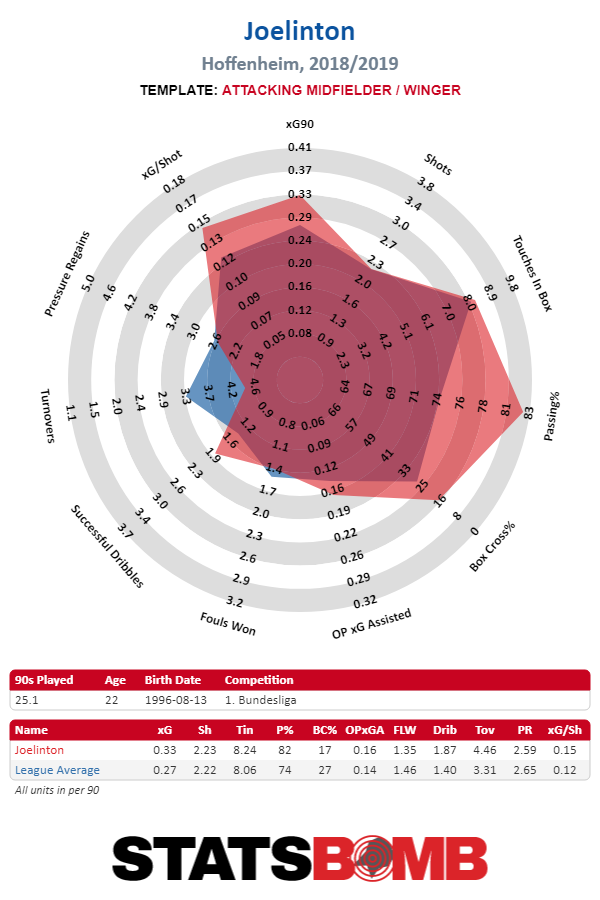 He moved around the Hoffenheim attack a little bit last season, spending a little time as a right-sided forward here and a little as an attacking midfielder there. There’s reason enough to be happy about this transfer, and he appears to have performed well in pre-season, although it’s a shame that it came after the rest of the attack was gutted. You could flip that thought, though. Joselu is 29, Rondon soon turns 30. Granted, Perez has only just turned 26, but a 25-year-old Almiron and 22-year-old Joelinton as the centre of the attack looks a lot more like squad-building than loaning in Salomon Rondon (as undeniably good as he was when he got going in 2018/19). That last paragraph perhaps gives Mike Ashley and co too much credit, especially given that mere survival in the Premier League this season won’t be an easy task. Joelinton is still, at time of writing, the only player that Newcastle have actually signed this summer, despite all their outgoings. However, there’s hope, and the prospect of Mike Ashley releasing some club funds again, on the horizon. Newcastle have been linked with 22-year-old Nice forward Allan Saint-Maximin, a young, nippy speedster who’s attracted a lot of attention. You can see why – he breaks the dribble scale, winging his way round wayward defenders 4.88 times per 90 minutes. StatsBomb’s template stops at 3.7 (the 95th percentile).
He moved around the Hoffenheim attack a little bit last season, spending a little time as a right-sided forward here and a little as an attacking midfielder there. There’s reason enough to be happy about this transfer, and he appears to have performed well in pre-season, although it’s a shame that it came after the rest of the attack was gutted. You could flip that thought, though. Joselu is 29, Rondon soon turns 30. Granted, Perez has only just turned 26, but a 25-year-old Almiron and 22-year-old Joelinton as the centre of the attack looks a lot more like squad-building than loaning in Salomon Rondon (as undeniably good as he was when he got going in 2018/19). That last paragraph perhaps gives Mike Ashley and co too much credit, especially given that mere survival in the Premier League this season won’t be an easy task. Joelinton is still, at time of writing, the only player that Newcastle have actually signed this summer, despite all their outgoings. However, there’s hope, and the prospect of Mike Ashley releasing some club funds again, on the horizon. Newcastle have been linked with 22-year-old Nice forward Allan Saint-Maximin, a young, nippy speedster who’s attracted a lot of attention. You can see why – he breaks the dribble scale, winging his way round wayward defenders 4.88 times per 90 minutes. StatsBomb’s template stops at 3.7 (the 95th percentile). 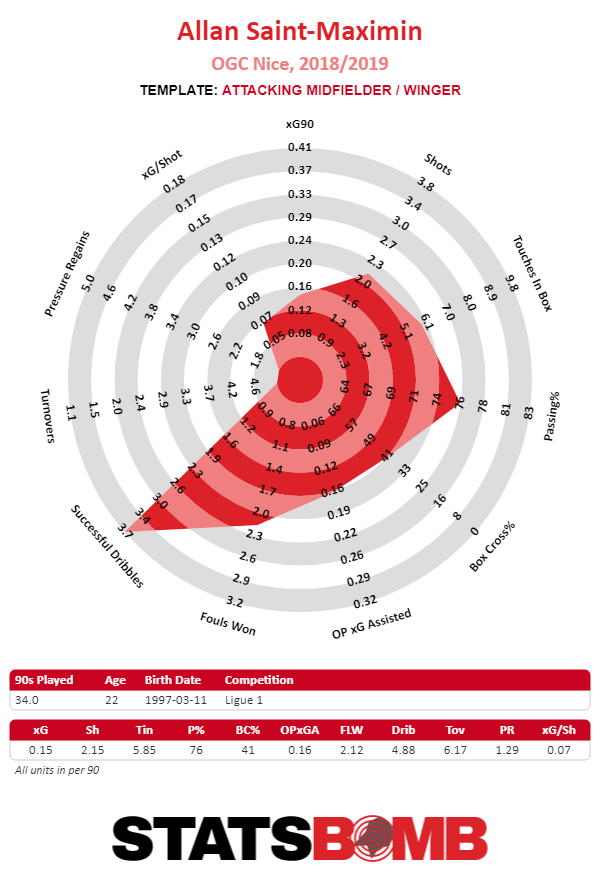 However, speed seems to be something of a crutch, and he doesn’t yet seem to have developed a reliable way of turning his dribbling ability into something more. https://twitter.com/StatsBomb/status/1156938976730787841?s=20 That doesn’t mean that he’ll be bad, by any stretch of the imagination, but one wouldn’t be surprised if Newcastle fans went through a stretches of being enamoured, and then annoyed, by their new signing. The only other confirmed incoming name is Steve Bruce into the dug-out. This feels far more in line with what we’ve come to expect from Ashley, and Bruce’s time at Sheffield Wednesday last season probably won’t inspire anyone on Tyneside all that much. Wednesday finished 12th last season, with Bruce arriving in February, a league average position for a generally league average-looking team. The Owls’ poor defence improved as the season went on, but the work was already done by the time that Bruce got there in February. He mostly seemed to have kept them on the same course that they were already on.
However, speed seems to be something of a crutch, and he doesn’t yet seem to have developed a reliable way of turning his dribbling ability into something more. https://twitter.com/StatsBomb/status/1156938976730787841?s=20 That doesn’t mean that he’ll be bad, by any stretch of the imagination, but one wouldn’t be surprised if Newcastle fans went through a stretches of being enamoured, and then annoyed, by their new signing. The only other confirmed incoming name is Steve Bruce into the dug-out. This feels far more in line with what we’ve come to expect from Ashley, and Bruce’s time at Sheffield Wednesday last season probably won’t inspire anyone on Tyneside all that much. Wednesday finished 12th last season, with Bruce arriving in February, a league average position for a generally league average-looking team. The Owls’ poor defence improved as the season went on, but the work was already done by the time that Bruce got there in February. He mostly seemed to have kept them on the same course that they were already on. 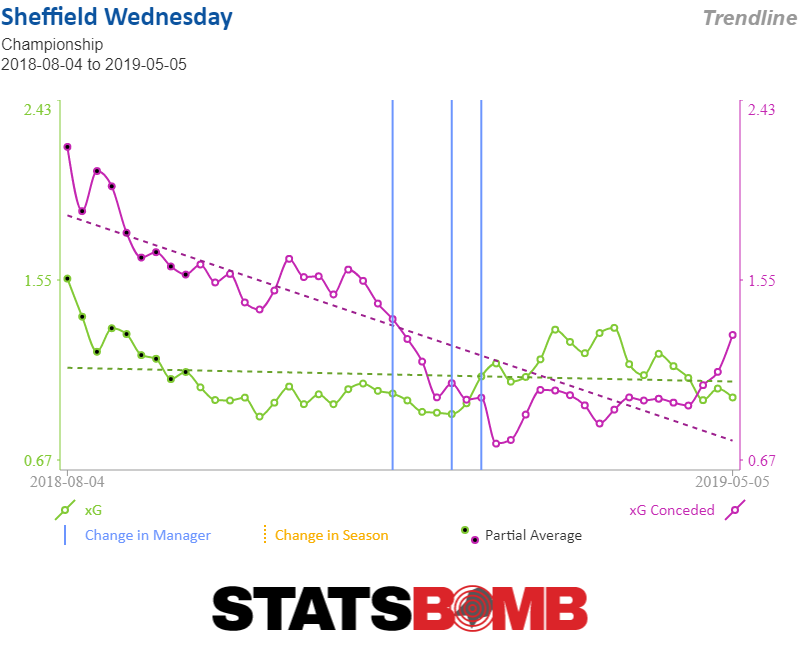 Bruce’s Premier League win rate has been highlighted before by those seeking to criticise the decision to appoint him, but it’s worth pointing out that he’s a particularly odd case. He’s in that class of managers who are native to the country and have been around a while. Because of that, he’s been in charge of a lot of teams near the plughole of the Premier League, far more than any other manager in the league. That’s not to say it’s a good appointment, but it feels unfair to judge him by that measure. His history, beyond just his Championship league-average spell at Sheffield Wednesday, doesn’t inspire a lot of confidence. When you think about the startlingly high bar of managerial talent in the league at the moment – Ralph Hasenhuttl, Graham Potter, Chris Wilder, Dean Smith all look good coaches, and that’s just the bottom of the league – things get even more tense. With an uninspiring choice of manager, and so few new signings, Newcastle fans will have to content themselves with looking forward to Miguel Almiron’s first full season in the Premier League. On the face of it, his output during the back end of 2018/19 didn’t look that great.
Bruce’s Premier League win rate has been highlighted before by those seeking to criticise the decision to appoint him, but it’s worth pointing out that he’s a particularly odd case. He’s in that class of managers who are native to the country and have been around a while. Because of that, he’s been in charge of a lot of teams near the plughole of the Premier League, far more than any other manager in the league. That’s not to say it’s a good appointment, but it feels unfair to judge him by that measure. His history, beyond just his Championship league-average spell at Sheffield Wednesday, doesn’t inspire a lot of confidence. When you think about the startlingly high bar of managerial talent in the league at the moment – Ralph Hasenhuttl, Graham Potter, Chris Wilder, Dean Smith all look good coaches, and that’s just the bottom of the league – things get even more tense. With an uninspiring choice of manager, and so few new signings, Newcastle fans will have to content themselves with looking forward to Miguel Almiron’s first full season in the Premier League. On the face of it, his output during the back end of 2018/19 didn’t look that great. 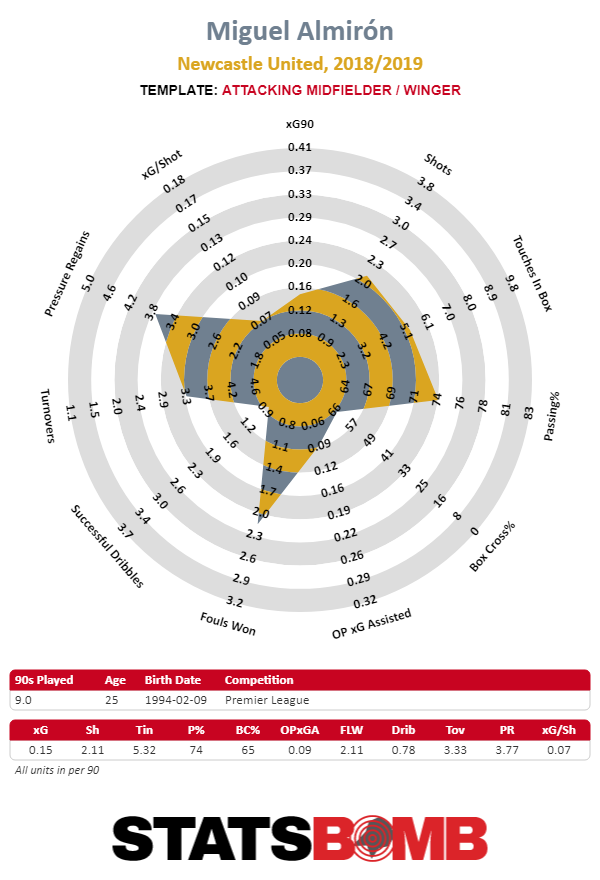 However, Almiron was a weird cog in the Newcastle machine. His pace, his excitement, and presumably what it allowed Benitez to do tactically with the team, seemed to revitalise the Magpies, even if the Paraguayan didn’t directly score or set up a goal. This gets captured when you take a step back and look at the possession sequences before the shots and key passes. Almiron was the most important part of the team for building up chances (that he didn’t then provide the shot or final pass for).
However, Almiron was a weird cog in the Newcastle machine. His pace, his excitement, and presumably what it allowed Benitez to do tactically with the team, seemed to revitalise the Magpies, even if the Paraguayan didn’t directly score or set up a goal. This gets captured when you take a step back and look at the possession sequences before the shots and key passes. Almiron was the most important part of the team for building up chances (that he didn’t then provide the shot or final pass for). 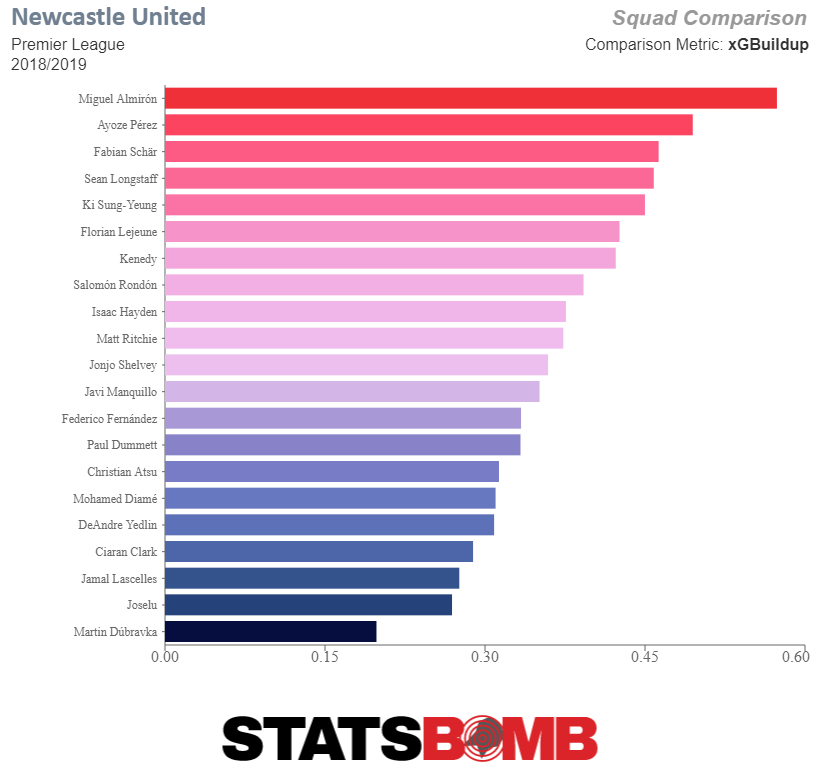 There’s also – and I’m aware this approaches blasphemy – a chance that the departure of Benitez won’t wholly be a bad thing. Newcastle’s performances under their former manager had a bizarre quirk when looking at their expected goals trendline. Things were moderately ok at the start of the season, got pretty bad, and then the attack would find their feet a bit and the defence would tighten up a bit enough to become a league average side and avoid relegation.
There’s also – and I’m aware this approaches blasphemy – a chance that the departure of Benitez won’t wholly be a bad thing. Newcastle’s performances under their former manager had a bizarre quirk when looking at their expected goals trendline. Things were moderately ok at the start of the season, got pretty bad, and then the attack would find their feet a bit and the defence would tighten up a bit enough to become a league average side and avoid relegation. 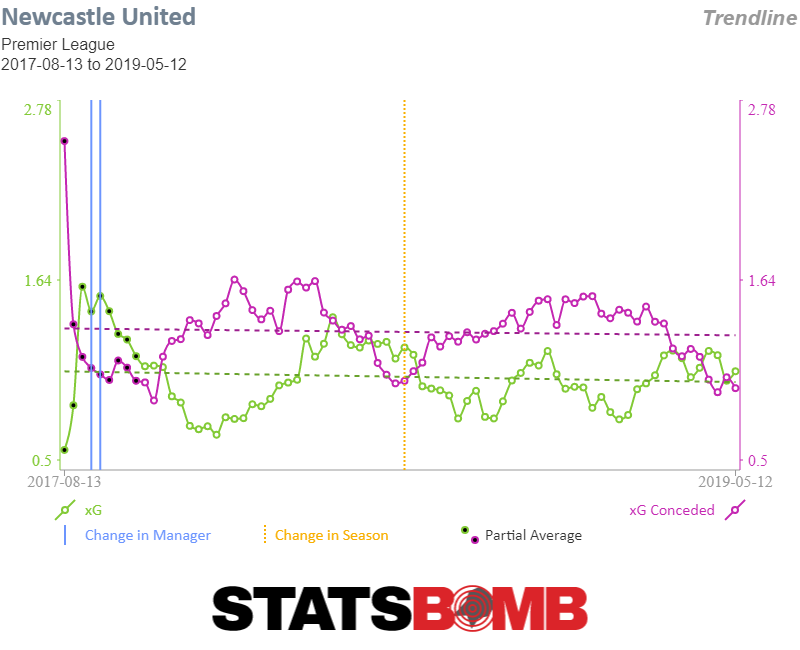 It’s a really strange trend, and makes you wonder about how Benitez’s reign would be thought of if he either hadn’t recovered things by the end of the season, or hadn’t let the team fall back in the first place. The pattern was less pronounced in the second season than the first, so maybe it was something that he was addressing. On the other hand, it’s interesting to look back on the jokes (jokes?) that were made about poor winter performances being a message to Mike Ashley to invest. Sure enough, Ashley bought Almiron in January. Either Benitez was only getting good performances out of his team when it counted, or he was orchestrating an incredibly complex game with the club’s owner. It seems a hell of a lot more likely that it was the former. Newcastle’s talent, in attack, is all still a little unproven in the league too. Muto, one match against Manchester United aside, never hit his stride; Almiron looked promising, but is yet to score or assist; Joelinton is a new signing, with all the uncertainty that brings, and the same would be the case for Saint-Maximin. Their good centre-backs and good goalkeeper should get them a certain amount of the way towards a competent defensive system, and Bruce, being an old-school man, will probably have them sit back and soak pressure. It’s interesting, and worrying, times. You could point to several teams in the league with a lower quality of squad. But the course of relegation never does run smooth, and it only takes a particularly poor run of form or cold streak in front of goal to put a big pothole in the road to safety. Header image courtesy of the Press Association
It’s a really strange trend, and makes you wonder about how Benitez’s reign would be thought of if he either hadn’t recovered things by the end of the season, or hadn’t let the team fall back in the first place. The pattern was less pronounced in the second season than the first, so maybe it was something that he was addressing. On the other hand, it’s interesting to look back on the jokes (jokes?) that were made about poor winter performances being a message to Mike Ashley to invest. Sure enough, Ashley bought Almiron in January. Either Benitez was only getting good performances out of his team when it counted, or he was orchestrating an incredibly complex game with the club’s owner. It seems a hell of a lot more likely that it was the former. Newcastle’s talent, in attack, is all still a little unproven in the league too. Muto, one match against Manchester United aside, never hit his stride; Almiron looked promising, but is yet to score or assist; Joelinton is a new signing, with all the uncertainty that brings, and the same would be the case for Saint-Maximin. Their good centre-backs and good goalkeeper should get them a certain amount of the way towards a competent defensive system, and Bruce, being an old-school man, will probably have them sit back and soak pressure. It’s interesting, and worrying, times. You could point to several teams in the league with a lower quality of squad. But the course of relegation never does run smooth, and it only takes a particularly poor run of form or cold streak in front of goal to put a big pothole in the road to safety. Header image courtesy of the Press Association
Month: August 2019
Sheffield United: 2019-20 Season Preview
A season of overachieving resources and confounding stereotypes was the story of Sheffield United’s promotion campaign. Hailing from the Steel City, the Blades’ success was more about their swagger than it was about the grit you might expect of their industrial roots. With an English manager in Chris Wilder, their play was more about intelligence and invention than it was about getting the basics right. The players, every single one of them of British or Irish nationality, played with verve and executed a style of play far more courageous than just knocking the ball into the channels. It’s exciting to see boyhood-blade Wilder get the chance to manage at the top level having unquestionably been the most successful manager of the EFL divisions in recent years. A sterling record of three promotions in four seasons starting with a League Two title at Northampton in 2015-16, followed by a League One title in his first season at Sheffield United in 2016-17 and, after falling short of the Championship play-offs in 2017-18, concluded with a 2nd place finish and promotion to the Premier League in 2018-19. It should also be said that only the League One side had a budget that suggested promotion would be the expectation. This is a man who took a Sheffield United side, heading nowhere fast, from League One to the Premier League in the space of three years. The success he’s brought and the style in which they’ve achieved it has not gone unnoticed by the educated eyes within the game either. When one of the most studied coaches of all time says this about you, you’re probably doing something right. “… the Sheffield United head coach is someone with new ideas and I have seen very few people with these ideas,” Marcelo Bielsa there.
Style & Build Up
Covering for the side’s lack of raw pace, the 3-4-1-2 was designed to create and maintain pressure on the opposition and a couple of the methods used to keep the game in the opposition half as much as possible are quite eye catching. First, the use of center backs as an extra attacker in possession. This was a regular occurrence and United’s most obvious form of overloading the opposition because of course a wing back, ball-side central midfielder and #10 combining to try and play through the defensive block just isn’t enough bodies. It really does have to be seen to be believed and with the likelihood that a more conservative style may be adopted in the top tier, we should take a moment to appreciate it whilst we can. 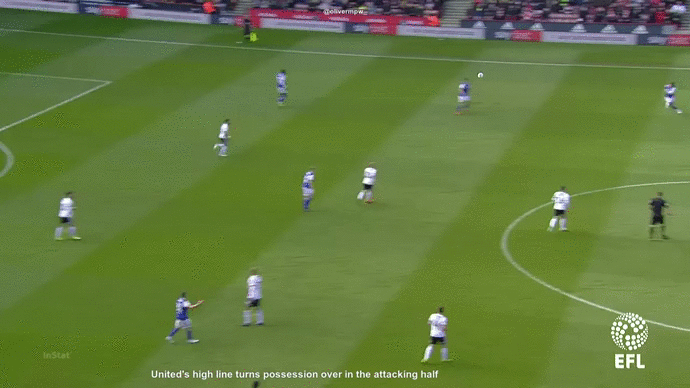 The numerical overloads created by this strategy have clear advantages in the attacking phase but they also served a key purpose in the defensive transition too, where United would look to immediately press should they lose the ball in the final third with the high number of players already around the ball making it an obvious strategy. You can see from their defensive activity map that, compared to the league average, the Blades were very active defenders high and wide up the pitch with the sheer numbers they’d often have in these areas a large reason why.
The numerical overloads created by this strategy have clear advantages in the attacking phase but they also served a key purpose in the defensive transition too, where United would look to immediately press should they lose the ball in the final third with the high number of players already around the ball making it an obvious strategy. You can see from their defensive activity map that, compared to the league average, the Blades were very active defenders high and wide up the pitch with the sheer numbers they’d often have in these areas a large reason why. 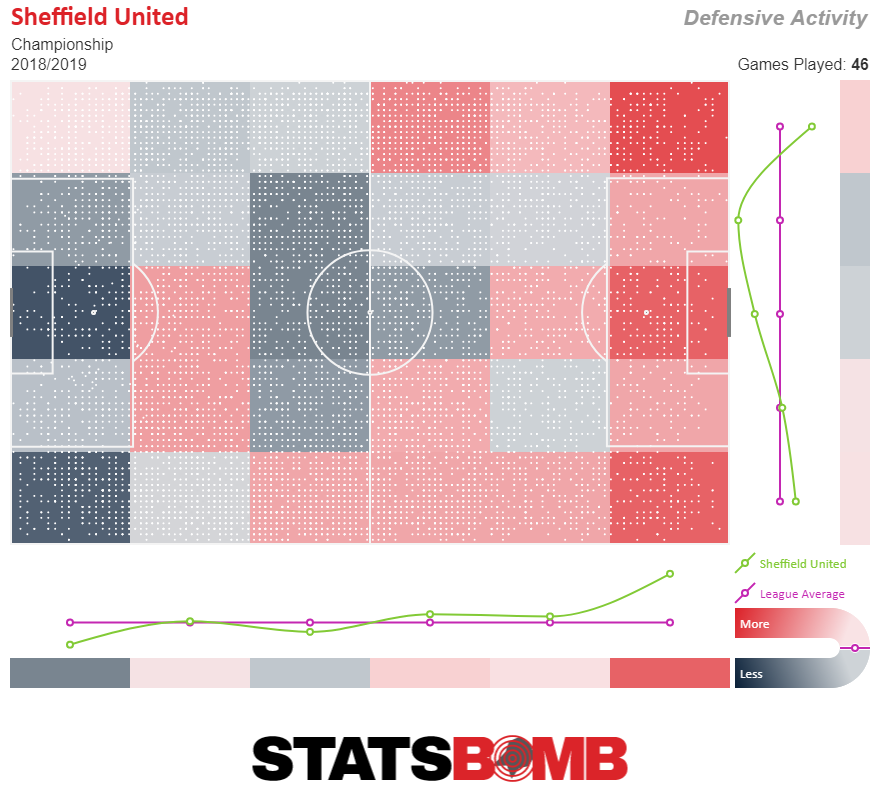 With Wilder’s system requiring a lot of positional and tactical intelligence from the players, one player excelled as the pivot and proverbial heartbeat of this Sheffield United side – Oliver Norwood. Securing his third straight promotion from the Championship (Brighton 16-17, Fulham 17-18), Norwood’s passing range and technique was crucial in stretching opponents and maintaining the pressure and momentum that Wilder cited as objective number one of his style of play. His passing sonar below highlights the range and frequency with which Norwood would spread the play.
With Wilder’s system requiring a lot of positional and tactical intelligence from the players, one player excelled as the pivot and proverbial heartbeat of this Sheffield United side – Oliver Norwood. Securing his third straight promotion from the Championship (Brighton 16-17, Fulham 17-18), Norwood’s passing range and technique was crucial in stretching opponents and maintaining the pressure and momentum that Wilder cited as objective number one of his style of play. His passing sonar below highlights the range and frequency with which Norwood would spread the play. 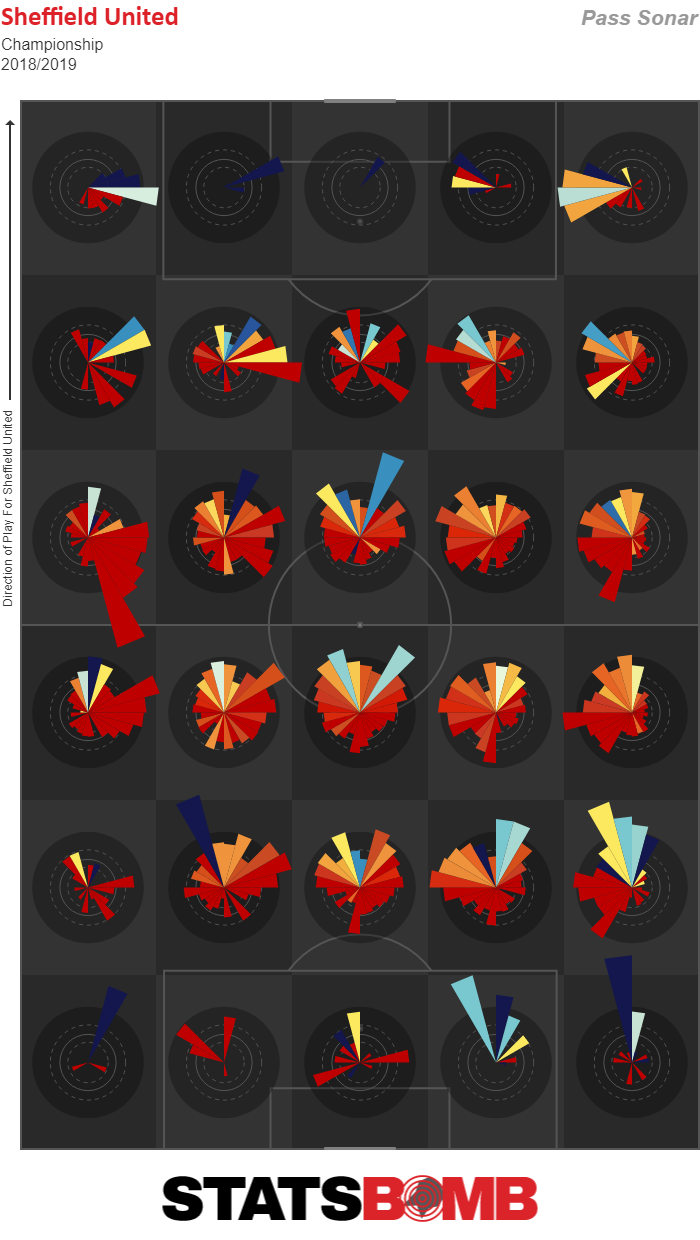 Not just captivating to watch though, their football was evidently highly successful. Statistically their approach throws up some really interesting trends when it comes to the chances they’d create and also the chances they concede, with wonderful symmetry at both ends. As you saw from the clip above, Sheffield United excelled at creating clear cut chances close to goal with the evergreen Billy Sharp often the main beneficiary, poaching most of his 22 non-penalty goals at the ripe old age of 33. The pressure created around the opponent’s goal and desire to get opportunities in the six -yard box is highlighted by the fact they led the Championship in the xG per shot and passes completed inside the box metrics, whilst they were 2nd in the league for the average shot distance they’d pull the trigger from.
Not just captivating to watch though, their football was evidently highly successful. Statistically their approach throws up some really interesting trends when it comes to the chances they’d create and also the chances they concede, with wonderful symmetry at both ends. As you saw from the clip above, Sheffield United excelled at creating clear cut chances close to goal with the evergreen Billy Sharp often the main beneficiary, poaching most of his 22 non-penalty goals at the ripe old age of 33. The pressure created around the opponent’s goal and desire to get opportunities in the six -yard box is highlighted by the fact they led the Championship in the xG per shot and passes completed inside the box metrics, whilst they were 2nd in the league for the average shot distance they’d pull the trigger from. 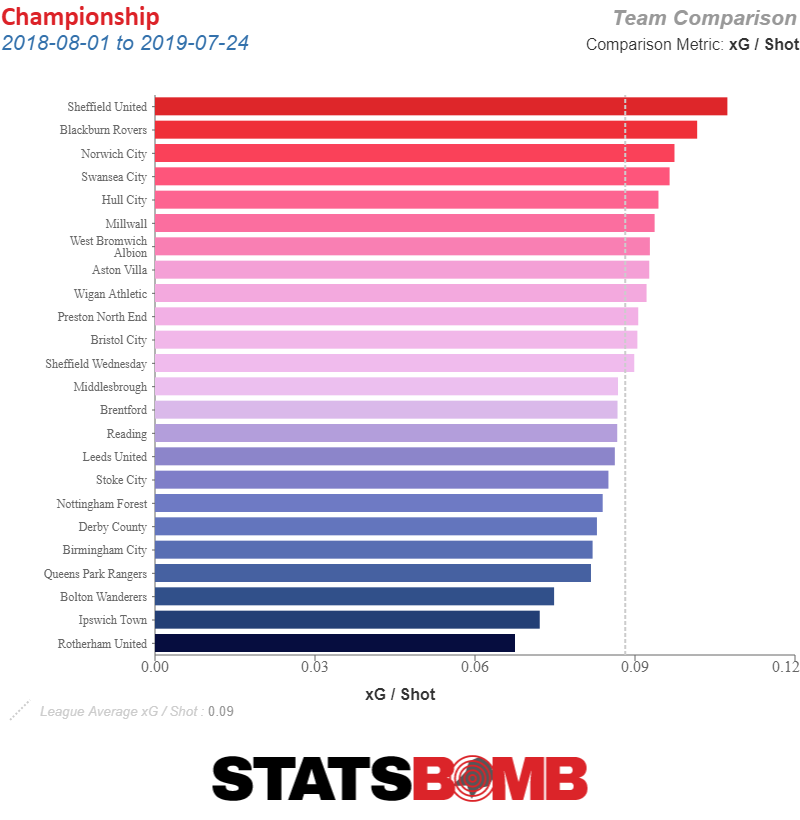 It was a similar story at the back, where the Blades ranked best in the league in xG per shot conceded and the average distance from goal of the shots they conceded was also furthest in the league.
It was a similar story at the back, where the Blades ranked best in the league in xG per shot conceded and the average distance from goal of the shots they conceded was also furthest in the league. 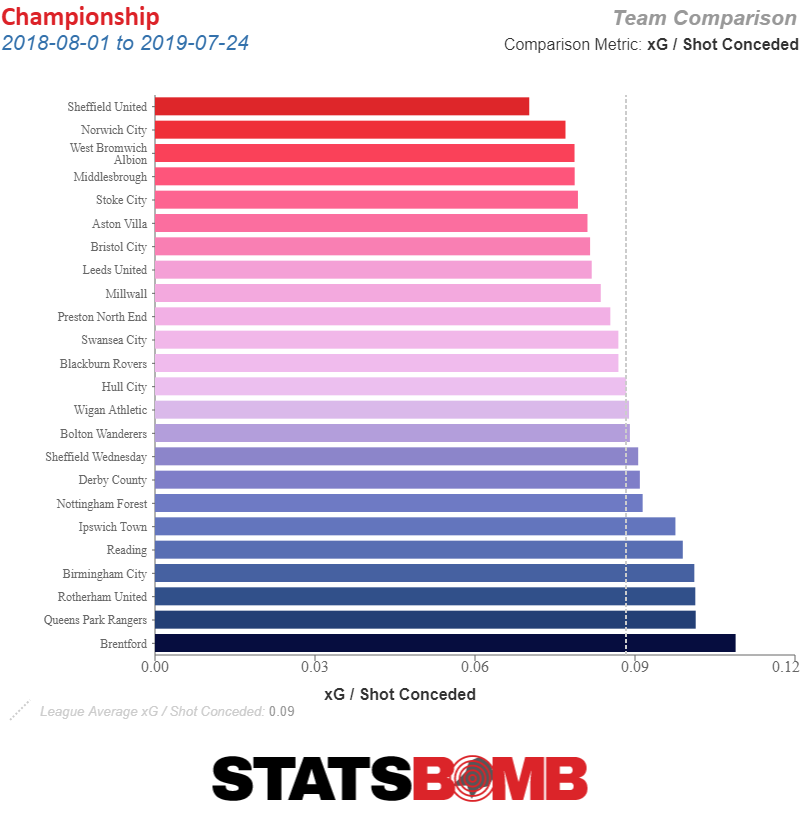 They were well drilled and effective in open play but their innovation at set plays, already written about previously, was a big factor in getting them over the line. The Blades were actually quite quiet on this front in the first two-thirds of the campaign, jostling themselves into the promotion picture on the back of their open play prowess with just six set play goals in the first 29 games (a rate of 0.20 per game) up to February 1st. From that date onwards though, they relied more on their set play invention to decide games in their favour with their set-play goals per game rate shooting up to 0.58 in the final 17 fixtures for a total of ten goals. Their strength and know-how in this phase of play could well be a tipping point in their avoiding relegation or not.
They were well drilled and effective in open play but their innovation at set plays, already written about previously, was a big factor in getting them over the line. The Blades were actually quite quiet on this front in the first two-thirds of the campaign, jostling themselves into the promotion picture on the back of their open play prowess with just six set play goals in the first 29 games (a rate of 0.20 per game) up to February 1st. From that date onwards though, they relied more on their set play invention to decide games in their favour with their set-play goals per game rate shooting up to 0.58 in the final 17 fixtures for a total of ten goals. Their strength and know-how in this phase of play could well be a tipping point in their avoiding relegation or not.
Transfers and Incomings
Despite promotion, Wilder is curiously still yet to delve into the foreign market to strengthen his side, preferring instead to pluck some of the better young performers from the Championship and other, predominantly British players who share a similar ravenous hunger possessed by his current squad to prove themselves in the Premier League. Though United aren’t expected to adopt an ultra-defensive philosophy, it’s clear they won’t be able to play the game as high up the pitch as they did against their 18-19 divisional rivals against much stronger opponents and it’s telling that most of their incomings so far have been in attacking areas, with homecoming Phil Jagielka the only defensive reinforcement at the time of writing. Acquiring a couple of “something out of nothing” players was high on Wilder’s shopping list for this transfer window and in Ravel Morrison and Callum Robinson they have two players that fit that bill. Morrison’s journey around the footballing globe and the possible reasons behind that have been well documented, but if Sheffield United can unlock the generational talent he possessed when coming through the Manchester United ranks, he could well make a positive difference in the same way he did before his sour departure from West Ham. In Robinson, the Blades have acquired one of the Championship’s better wide forwards and a player who adds not only pace but also the ability to create shots for himself and others off the dribble - something that simply didn’t exist in Sheffield United’s squad last season, though, in fairness, it wasn’t really required then. A more counterattacking and direct option is something that will solve a lot of problems the Blades are likely to encounter this season though and Robinson’s contribution in speeding up those attacking transitions, likely as a withdrawn forward in the 3-4-1-2, could be vital. Frenchman Lys Mousset is another who adds mobility to their front line and, at 23, crucially brings the average age of United’s attacking options down with their key attacking contributors last season – Billy Sharp (33 years old), David McGoldrick (31) and Mark Duffy (33) – all on the gentle decline of the age curve. Mousset’s motivations for joining the Blades are clear and twofold: to gloat about his European passport post-Brexit and to escape the substitutes bench, from which no fewer than 50 of his 58 Premier League appearances came. With only a select sample of minutes to draw firm conclusions from, this is a deal, like Ravel Morrison, made for the potential upside rather than any low-risk guaranteed contribution. And the upside is definitely there. Prior to his Bournemouth move in 2016 Mousset had just scored 14 goals for Le Havre in Ligue 2 and contributed to France U23’s run to the final of the Toulon tournament, attracting interest from some of the Premier League’s bigger names. Dean Henderson has signed on to keep goal in South Yorkshire for another year following a successful loan from Manchester United last season, whilst Ben Osborn and Luke Freeman have shown ability at Championship level and add versatility and depth to the squad.
Going Down With A Fight?
Going into this season it goes without saying that some adaptation to their cavalier methods will be required, with Wilder himself acknowledging that need, but even that may not be enough to save United from the drop. However, Wilder might model his approach on Eddie Howe and the way his Bournemouth side went about securing promotion to the Premier League and sticking to their expansive principles once there, suggesting perhaps those adaptations needn’t be as cautious as one might predict. That would certainly fit with Wilder’s character as a man not shy of puffing his chest out and forcing others to sit up and take notice. Make no mistake, this team will relish the prospect of turning up and spoiling the party for anyone who underestimates them. His legendary status at Bramall Lane also helps in this regard with his job secure even in the event of relegation and the freedom attached to having nothing to lose will very much aid their approach. The finer details may change, but don’t be surprised to see the unsuspected innovators innovate again. Header image courtesy of the Press Association
Liverpool: 2019-20 Season Preview
More of the same? In football, as in life, there are the things you can influence and the things you can’t. In the first column, Liverpool put up their best Premier League year ever, amassing a 97 point haul that would have been enough to lift the title in all but one of the previous 38 game seasons. In the second column, Manchester City went and got 98 points. In a season when everything went right for Liverpool, there was still another team in the land just ever so slightly better. Then again, it’s fair to say that winning the Champions League can soften the blow a bit. As these things go, the numbers contain both good news and bad news for Liverpool. The good news is that they were clearly the second best team, a cut above all other challengers bar City. The bad news is that City were a solid chunk stronger in terms of expected goals both for and against. 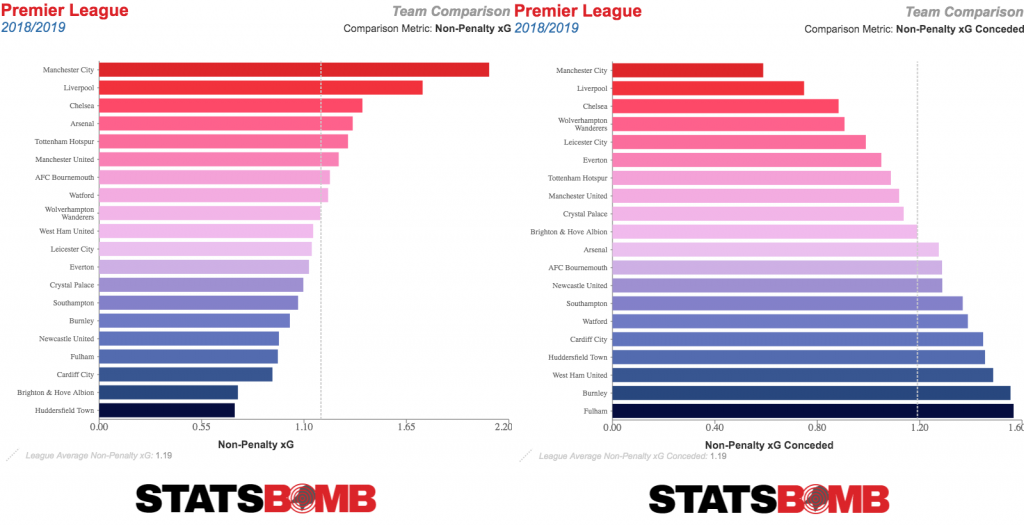 And this isn’t exactly a new story. Except for an early mess at the start of the 2017/18 season, Liverpool have been basically this good for ages now.
And this isn’t exactly a new story. Except for an early mess at the start of the 2017/18 season, Liverpool have been basically this good for ages now. 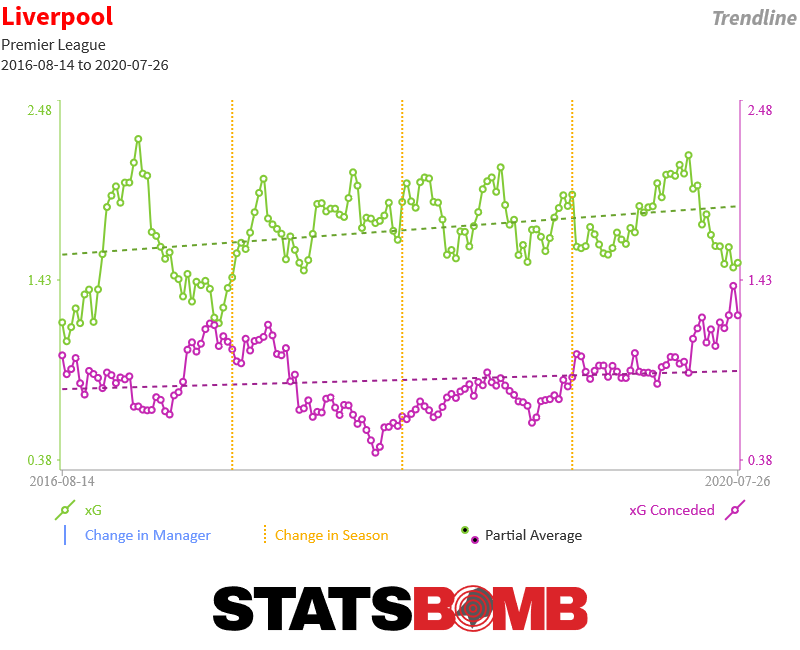 In terms of how Jürgen Klopp’s side do it, well there’s not a lot of new news there, either. After flirting with a 4-2-3-1 for a while, Liverpool have gone back to the tried and trusted 4-3-3. With each passing year, the team have become less and less reliant on possession to create chances while growing more adept at creating counter-pressing opportunities. We’re getting close to the platonic ideal of a Klopp side. There were various questions in the first half of the season about Liverpool turning down the high press somewhat, but that was not entirely visible in our numbers. The side’s defensive distance, the average location up the pitch at which a defensive act was made, actually increased a touch from 2017/18. When it came to where Liverpool looked to stifle the opposition, Klopp’s men were the second highest up the pitch in the league after Pep Guardiola’s Man City.
In terms of how Jürgen Klopp’s side do it, well there’s not a lot of new news there, either. After flirting with a 4-2-3-1 for a while, Liverpool have gone back to the tried and trusted 4-3-3. With each passing year, the team have become less and less reliant on possession to create chances while growing more adept at creating counter-pressing opportunities. We’re getting close to the platonic ideal of a Klopp side. There were various questions in the first half of the season about Liverpool turning down the high press somewhat, but that was not entirely visible in our numbers. The side’s defensive distance, the average location up the pitch at which a defensive act was made, actually increased a touch from 2017/18. When it came to where Liverpool looked to stifle the opposition, Klopp’s men were the second highest up the pitch in the league after Pep Guardiola’s Man City. 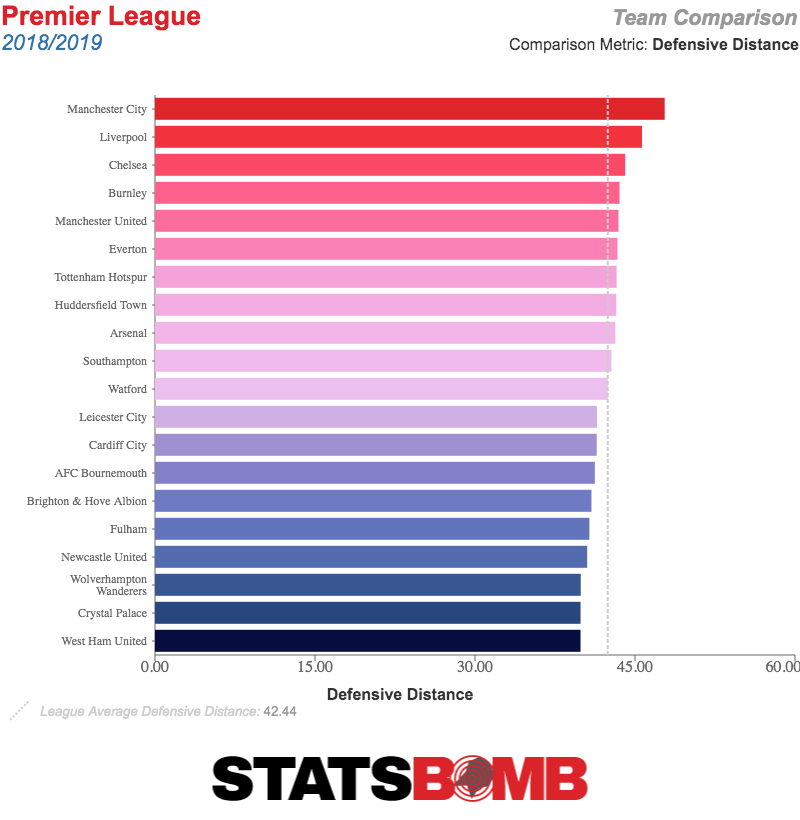 The team’s passes per defensive action, the number of passes an opponent is allowed before an attempt to win the ball back is made, increased a touch, with Liverpool now allowing teams on average half a pass more before making a defensive action. But this is all well within the range of normal fluctuation, and still puts Liverpool as one of the more aggressive ball winners in the league.
The team’s passes per defensive action, the number of passes an opponent is allowed before an attempt to win the ball back is made, increased a touch, with Liverpool now allowing teams on average half a pass more before making a defensive action. But this is all well within the range of normal fluctuation, and still puts Liverpool as one of the more aggressive ball winners in the league. 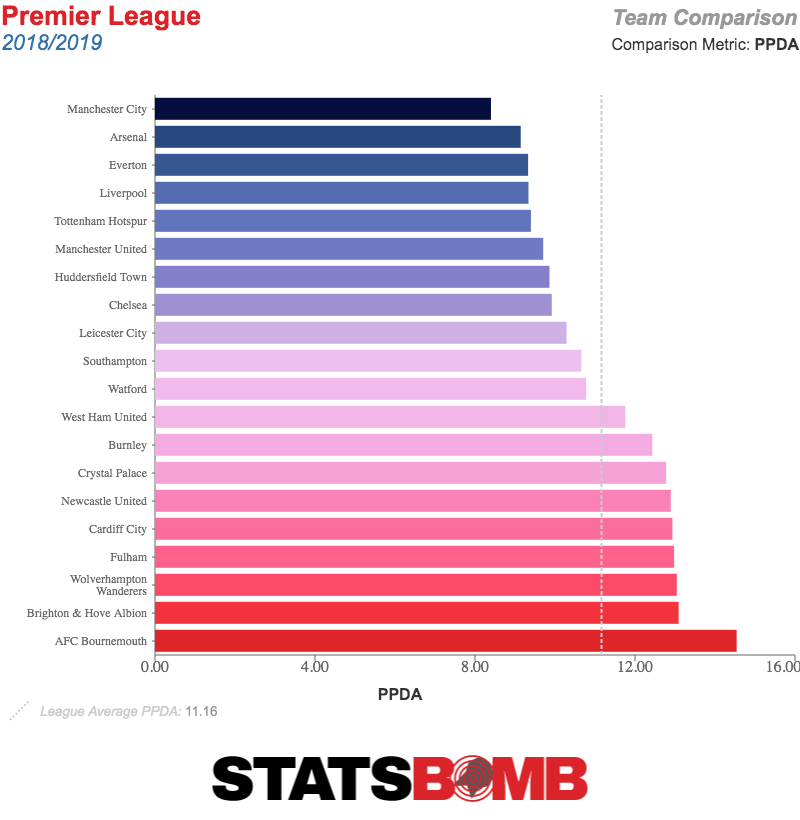 Whenever anyone talks about this team, it’s the front three that they want to bring up. Mohamed Salah, Sadio Mané and Roberto Firmino between them accounted for 65% of Liverpool’s xG last season and 68% of the goals. The extent to which Liverpool’s attacking play is about moving the ball quickly to the forward line and exploiting their speed and movement in moments of transition is fairly obvious to anyone who has watched them. Though Mané began to earn some headlines for his goals in important moments, Salah remains the star here, leading the side in xG and xG assisted, as well as offering more in terms of progressing the ball in various ways, even as things were down somewhat from the previous season. It did feel as though this was of a result of opposing sides paying closer attention to him after his breakout year, in turn freeing up space for Mané and Firmino as he attracted more defenders to him. It will be an interesting subplot to see how much this evens out in 2019/20 after a more subdued year. Really, the more you look at it, the more it appears that Liverpool have stayed the same. The team added 22 points from 2017/18 to 2018/19, but there’s very little evidence of change in terms of performances. They are what they are.
Whenever anyone talks about this team, it’s the front three that they want to bring up. Mohamed Salah, Sadio Mané and Roberto Firmino between them accounted for 65% of Liverpool’s xG last season and 68% of the goals. The extent to which Liverpool’s attacking play is about moving the ball quickly to the forward line and exploiting their speed and movement in moments of transition is fairly obvious to anyone who has watched them. Though Mané began to earn some headlines for his goals in important moments, Salah remains the star here, leading the side in xG and xG assisted, as well as offering more in terms of progressing the ball in various ways, even as things were down somewhat from the previous season. It did feel as though this was of a result of opposing sides paying closer attention to him after his breakout year, in turn freeing up space for Mané and Firmino as he attracted more defenders to him. It will be an interesting subplot to see how much this evens out in 2019/20 after a more subdued year. Really, the more you look at it, the more it appears that Liverpool have stayed the same. The team added 22 points from 2017/18 to 2018/19, but there’s very little evidence of change in terms of performances. They are what they are. 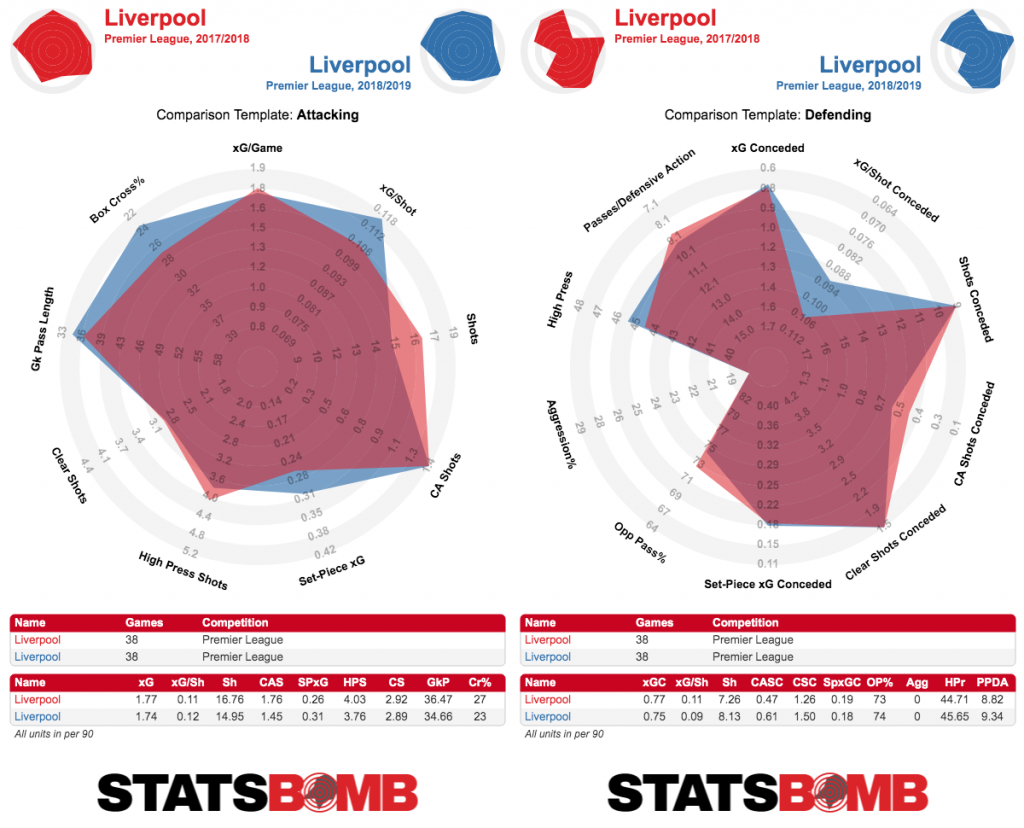 One thing that did change indisputably, and was arguably the biggest factor in the stronger results, was in the goalkeeper position. Simon Mignolet and Loris Karius both rested somewhere on a spectrum between adequate and awful, depending on who you asked. But such question marks were not apparent with Alisson. The model estimates that the Brazilian saved 5.06 goals more than the average keeper would’ve managed from those shots in the Premier League last season, ranking as the fourth best shot stopper in the division.
One thing that did change indisputably, and was arguably the biggest factor in the stronger results, was in the goalkeeper position. Simon Mignolet and Loris Karius both rested somewhere on a spectrum between adequate and awful, depending on who you asked. But such question marks were not apparent with Alisson. The model estimates that the Brazilian saved 5.06 goals more than the average keeper would’ve managed from those shots in the Premier League last season, ranking as the fourth best shot stopper in the division. 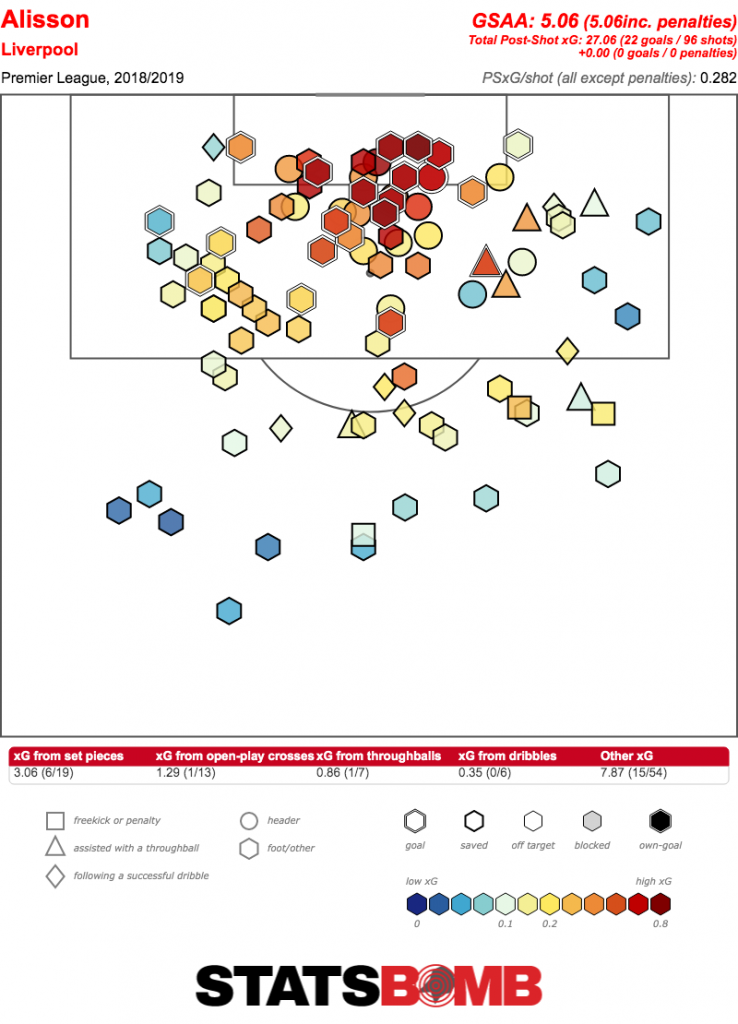 Predicting how many goals a goalkeeper will save between seasons is fraught with difficulty. For all we know, a number of strikers will just happen to kick the ball so perfectly against Alisson that there’s not a damn thing he’ll be able to do about it. But it does seem pretty likely that he’s an above average shot stopper, so the expectation should probably be that he saves more than average again. The vast majority of Liverpool’s defensive overperformance was down to more saves being made than expected rather than opposing players failing to hit the target (of the 29.46 xG conceded, 27.06 of it made it across to the post-shot model, so teams were not having a dramatically unusually difficult time hitting the target against Liverpool), so this might be repeatable. But the error bars are large on this. On the attacking side, there was a fair amount of overperformance (82 non-penalty goals scored against 66.98 expected) for the second year in a row. At least some of that can be accounted for by set pieces:
Predicting how many goals a goalkeeper will save between seasons is fraught with difficulty. For all we know, a number of strikers will just happen to kick the ball so perfectly against Alisson that there’s not a damn thing he’ll be able to do about it. But it does seem pretty likely that he’s an above average shot stopper, so the expectation should probably be that he saves more than average again. The vast majority of Liverpool’s defensive overperformance was down to more saves being made than expected rather than opposing players failing to hit the target (of the 29.46 xG conceded, 27.06 of it made it across to the post-shot model, so teams were not having a dramatically unusually difficult time hitting the target against Liverpool), so this might be repeatable. But the error bars are large on this. On the attacking side, there was a fair amount of overperformance (82 non-penalty goals scored against 66.98 expected) for the second year in a row. At least some of that can be accounted for by set pieces: 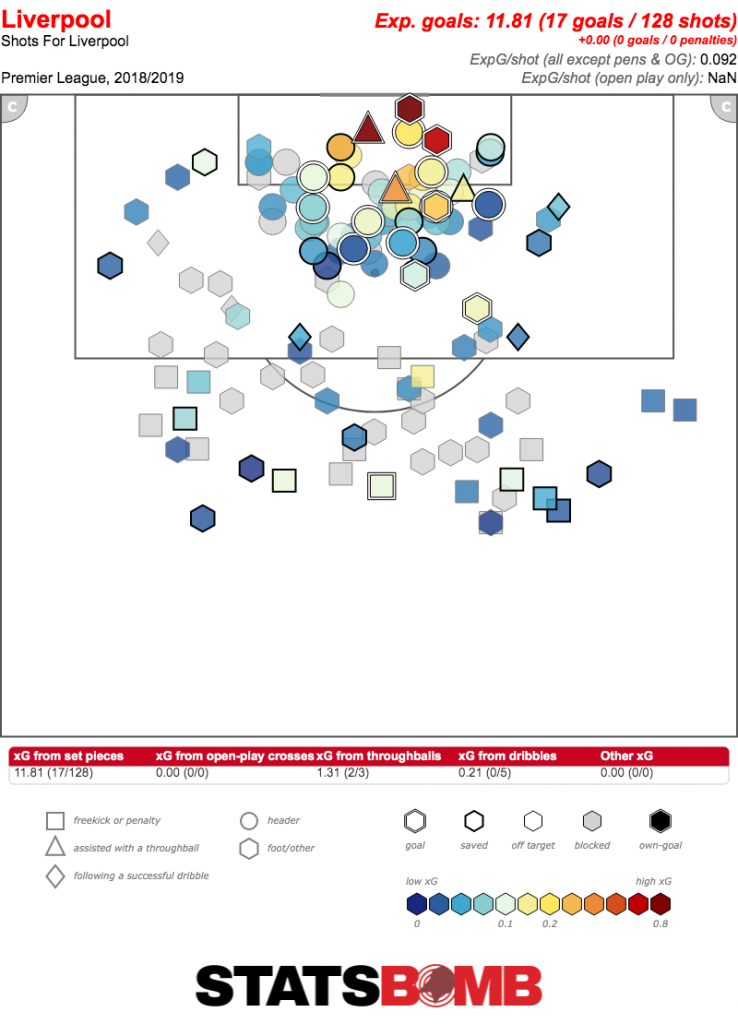 The importance of set pieces to Liverpool has been widely remarked upon. No team managed more last season than the team’s 17. Looking from the outside in, it also seems very likely that Liverpool are finding certain edges in this area of the game, and doing things differently than other clubs. It’s the kind of thing that could easily trick an xG model, though it’s tough to say for sure and we’ll have a better sense after another season. Liverpool did not significantly overperform on set pieces in 17/18 (12 goals scored against 10.13 expected) but may well have found new edges since then. It’s something to watch out for. Open play also saw an overperformance of around ten goals. Now, Liverpool do attack with some very pacey forwards, and one could imagine there might be times when they create chances a little better than the model says. But the expectation should be for Liverpool’s open play finishing to return to a more normal rate. Of the various elements to the team’s xG overperformance, this is the hardest to justify.
The importance of set pieces to Liverpool has been widely remarked upon. No team managed more last season than the team’s 17. Looking from the outside in, it also seems very likely that Liverpool are finding certain edges in this area of the game, and doing things differently than other clubs. It’s the kind of thing that could easily trick an xG model, though it’s tough to say for sure and we’ll have a better sense after another season. Liverpool did not significantly overperform on set pieces in 17/18 (12 goals scored against 10.13 expected) but may well have found new edges since then. It’s something to watch out for. Open play also saw an overperformance of around ten goals. Now, Liverpool do attack with some very pacey forwards, and one could imagine there might be times when they create chances a little better than the model says. But the expectation should be for Liverpool’s open play finishing to return to a more normal rate. Of the various elements to the team’s xG overperformance, this is the hardest to justify. 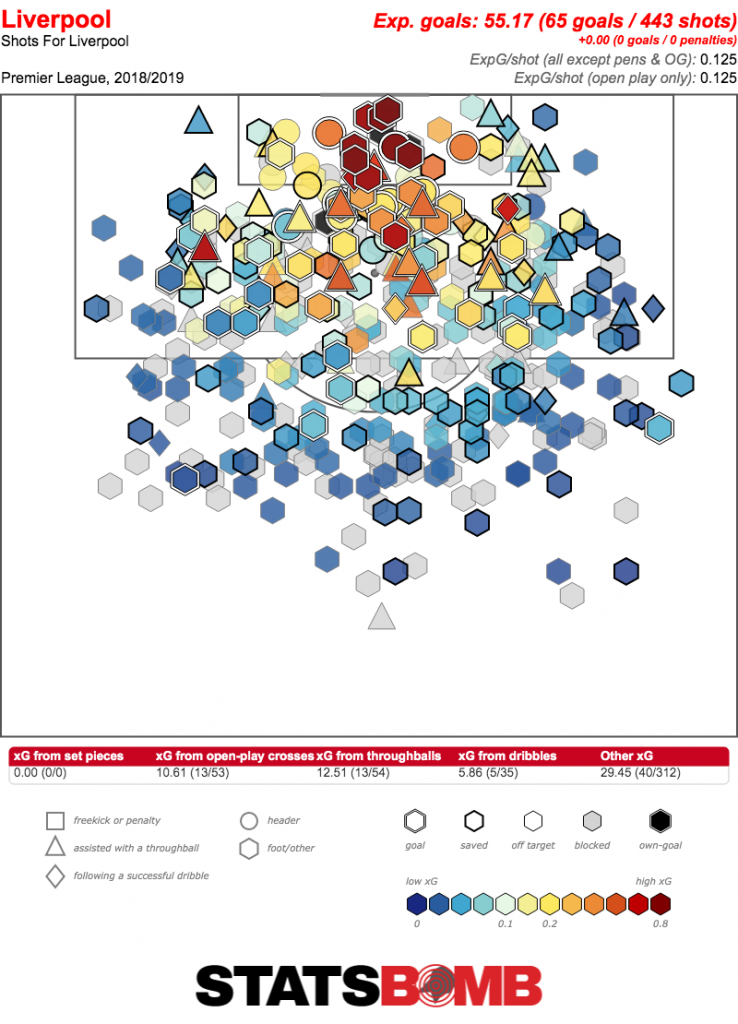 Now, this is the point where one would generally talk about the new signings. Only problem is there’s not exactly a lot of movement. Seventeen year old Sepp van den Berg has now been joined by 16 year old Harvey Elliott and, well, that’s it. There is talk that the club still want to sign a “versatile left-sided player”, whatever that means, but he would likely be the only new recruit old enough to legally enjoy a bottle of beer on the team bus after a game. As for the pair, Van den Berg is predominantly a centre back who has filled in at right back at times, and with Nathaniel Clyne’s injury (and no incomings) he may actually get some minutes on that side of the pitch. Elliott is a left footed attacking player who probably won’t make more than a few cameo appearances in the senior side. So if we’re going to see any evolution in this team whatsoever, it’ll be from the players already there. Leading nominee at the Like A New Signing Awards is Alex Oxlade-Chamberlain. While he took a fair period of adjustment after signing from Arsenal, the midfielder had really hit a good vein of form in the 2017/18 season before injury. Playing as the most advanced midfielder in the 4-3-3, especially after Philippe Coutinho was sold, Oxlade-Chamberlain was a really important cog in how Liverpool got the ball to the front three. Klopp tweaked things somewhat in his absence, putting more emphasis on the fullbacks and compensating by using the midfield three more conservatively. The return of Oxlade-Chamberlain gives Klopp the opportunity to switch this up at times. With the volume of assists Alexander-Arnold and Robertson amassed last season, opposing sides may well place more emphasis on shutting down Liverpool’s fullbacks, and as such, the ability to put in Oxlade-Chamberlain and progress the ball through the centre more would be a good option.
Now, this is the point where one would generally talk about the new signings. Only problem is there’s not exactly a lot of movement. Seventeen year old Sepp van den Berg has now been joined by 16 year old Harvey Elliott and, well, that’s it. There is talk that the club still want to sign a “versatile left-sided player”, whatever that means, but he would likely be the only new recruit old enough to legally enjoy a bottle of beer on the team bus after a game. As for the pair, Van den Berg is predominantly a centre back who has filled in at right back at times, and with Nathaniel Clyne’s injury (and no incomings) he may actually get some minutes on that side of the pitch. Elliott is a left footed attacking player who probably won’t make more than a few cameo appearances in the senior side. So if we’re going to see any evolution in this team whatsoever, it’ll be from the players already there. Leading nominee at the Like A New Signing Awards is Alex Oxlade-Chamberlain. While he took a fair period of adjustment after signing from Arsenal, the midfielder had really hit a good vein of form in the 2017/18 season before injury. Playing as the most advanced midfielder in the 4-3-3, especially after Philippe Coutinho was sold, Oxlade-Chamberlain was a really important cog in how Liverpool got the ball to the front three. Klopp tweaked things somewhat in his absence, putting more emphasis on the fullbacks and compensating by using the midfield three more conservatively. The return of Oxlade-Chamberlain gives Klopp the opportunity to switch this up at times. With the volume of assists Alexander-Arnold and Robertson amassed last season, opposing sides may well place more emphasis on shutting down Liverpool’s fullbacks, and as such, the ability to put in Oxlade-Chamberlain and progress the ball through the centre more would be a good option. 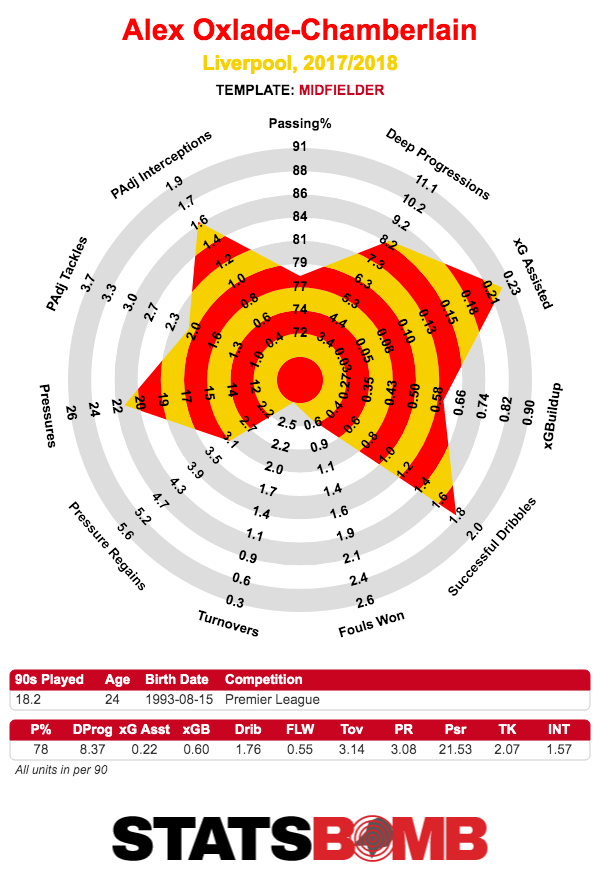 Another player who could easily benefit from a more midfield-focused ball progression approach is Naby Keïta. A long time favourite around these parts, so far Liverpool fans may be understandably underwhelmed by the Guinean’s performances. There was discussion about whether he was playing with an injury last season, lacking confidence or just having a hard time adapting to the Premier League. As frustrating as his fitness disrupted first season at Anfield often felt, on a purely stats basis, he looked fine. More then fine, actually, offering a lot in terms of progressing the ball forward while getting through a large volume of defensive work. When you split his season in terms of up until the end of January against February onwards, you get more of a sense of what’s happening, with Keïta finally hitting his stride in 2019 before another injury cut his season short.
Another player who could easily benefit from a more midfield-focused ball progression approach is Naby Keïta. A long time favourite around these parts, so far Liverpool fans may be understandably underwhelmed by the Guinean’s performances. There was discussion about whether he was playing with an injury last season, lacking confidence or just having a hard time adapting to the Premier League. As frustrating as his fitness disrupted first season at Anfield often felt, on a purely stats basis, he looked fine. More then fine, actually, offering a lot in terms of progressing the ball forward while getting through a large volume of defensive work. When you split his season in terms of up until the end of January against February onwards, you get more of a sense of what’s happening, with Keïta finally hitting his stride in 2019 before another injury cut his season short. 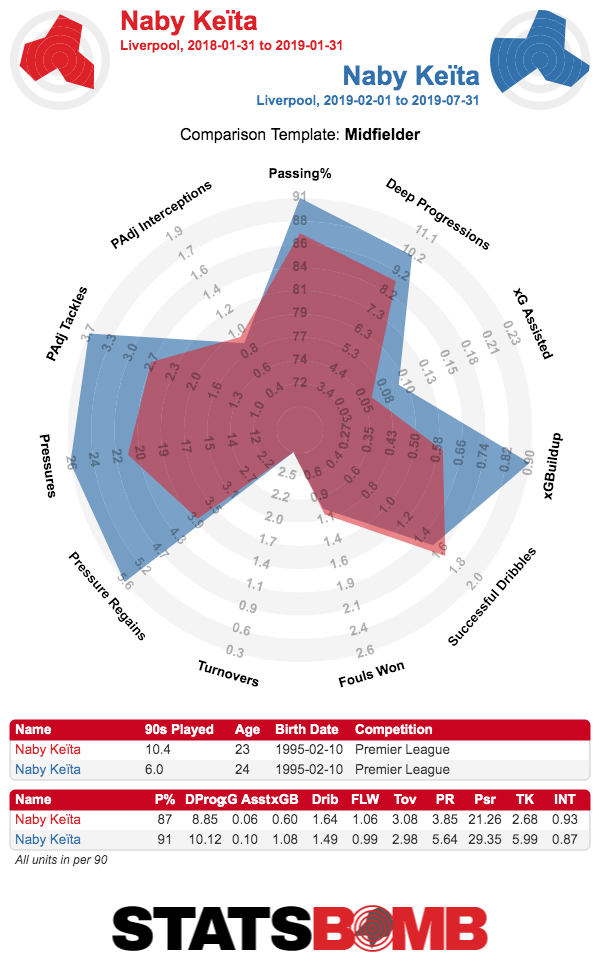 What’s frustrating is that Keïta was brought straight back into action in order to play for Guinea at the Africa Cup of Nations. The good news is that he started the most recent friendly against Lyon and thus should be able to feature early in the season. But this is a repeated instance of him being brought back very quickly, and injuries could recur more and more. If this can be avoided, Liverpool have an outstanding player yet to be fully unlocked. Elsewhere in terms of adding value from within, Rhian Brewster is fit again and remains a great hope. Considering the progress of other 2017 Under-17 World Cup winning stars Jadon Sancho, Phil Foden, Callum Hudson-Odoi and Morgan Gibbs-White, that tournament’s Golden Boot and Bronze Ball winner can not unrealistically aim to make similar progress, provided he has fully recovered from his long spell out. Though, much like Foden has found at City, it can be difficult for these players to get real minutes at a side challenging for major trophies. Minutes could well be available for him if Salah, Mané and Firmino do not stay as fit as they generally did last season. Liverpool’s relative luck with fitness has been mentioned by many, and while I would argue this overlooks serious injuries to Oxlade-Chamberlain, Keïta, Brewster and Joe Gomez, this team has been about the front three for the past 18 months. To show signs of evolution, a greater emphasis on midfield play will need to develop, though it seems unlikely that Klopp will try to tweak things too much. There’s no getting around the fact that, though just one point separated Liverpool and Man City in the league table, the underlying numbers paint a much larger gap. Though there may be edges here and there, Klopp’s side likely will run closer to expected goals at both ends of the pitch this season. The 25 point gap down to the rest still feels too big a gap for any side to likely close, but Liverpool might have to settle for being closer to the chasing pack than the top tier this time out. Header image courtesy of the Press Association
What’s frustrating is that Keïta was brought straight back into action in order to play for Guinea at the Africa Cup of Nations. The good news is that he started the most recent friendly against Lyon and thus should be able to feature early in the season. But this is a repeated instance of him being brought back very quickly, and injuries could recur more and more. If this can be avoided, Liverpool have an outstanding player yet to be fully unlocked. Elsewhere in terms of adding value from within, Rhian Brewster is fit again and remains a great hope. Considering the progress of other 2017 Under-17 World Cup winning stars Jadon Sancho, Phil Foden, Callum Hudson-Odoi and Morgan Gibbs-White, that tournament’s Golden Boot and Bronze Ball winner can not unrealistically aim to make similar progress, provided he has fully recovered from his long spell out. Though, much like Foden has found at City, it can be difficult for these players to get real minutes at a side challenging for major trophies. Minutes could well be available for him if Salah, Mané and Firmino do not stay as fit as they generally did last season. Liverpool’s relative luck with fitness has been mentioned by many, and while I would argue this overlooks serious injuries to Oxlade-Chamberlain, Keïta, Brewster and Joe Gomez, this team has been about the front three for the past 18 months. To show signs of evolution, a greater emphasis on midfield play will need to develop, though it seems unlikely that Klopp will try to tweak things too much. There’s no getting around the fact that, though just one point separated Liverpool and Man City in the league table, the underlying numbers paint a much larger gap. Though there may be edges here and there, Klopp’s side likely will run closer to expected goals at both ends of the pitch this season. The 25 point gap down to the rest still feels too big a gap for any side to likely close, but Liverpool might have to settle for being closer to the chasing pack than the top tier this time out. Header image courtesy of the Press Association
